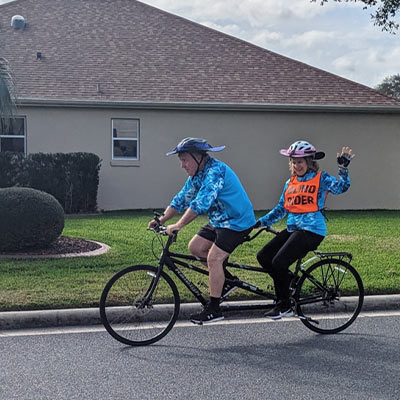Carol Kitchen is an active person. She takes line dancing lessons, rides a tandem bicycle with her husband, plays games and goes bowling with her low-vision support group—and much more. And while she knows her approach to these activities may be a bit unusual, she’s perfectly happy with that. In fact, Carol’s mindset is, “I may do it a little differently, and I may look a bit different while I’m doing it. But I can still do it.”
Carol’s journey with vision loss started when she was about 5 years old. She couldn’t see the board at the front of the class, and at first, the adults in her life didn’t know what was going on. “The teachers were pinning notes to my coat,” she says—notes like, “Carol seems very bright, but she’s just not getting it.” But it didn’t take long to understand that she was having difficulties with her vision—not with learning—and that’s when she started to see eye doctors. It took several years for the doctors to fully understand Carol’s condition—but after a while, she was diagnosed with Stargardt disease, an inherited form of macular degeneration.
As a child and a teenager, Carol says she tried to hide her vision loss, “because you don’t want to stand out then.” But over time, her perspective has changed—and by the time she got to college, she was ready to let it be a normal part of her life. Now, she embraces the opportunity to try something new, every chance she gets. And line dancing is a great example.
When Carol started going to line dancing classes, she made sure to always stand in the front. But that didn’t help very much on its own. “I can only see about 3 feet in front of me,” she says, “And even that is very blurry.” But Carol was dedicated to learning, so she talked with the instructor, who was “all about wanting to do this with me,” she says. Now the instructor has changed her way of teaching, carefully explaining every little movement. Carol also does some prep work at home, going online to read the step sheets—instructions that describe the moves—ahead of time. “Am I as good as everyone else?” she muses. “Well, I think I hold my own, and when I mess up, you know, it’s OK.” As usual, Carol says, the important thing is having an open mind to say, "I might do it differently.”
Thinking outside the box helped Carol discover new ways to do things in her finance and accounting career, too. Still, as her vision loss progressed, she felt that she couldn’t keep up with the amount of work she wanted to get done. “I think that is one very big struggle and challenge that a lot of people with vision loss have,” she says. “They are going to be a little bit slower at doing things. That was probably one of my big frustrations. And possibly still is.”
As a result, Carol retired—and it turns out, that’s been wonderful. “We moved to the largest retirement village in Florida,” she says, “so I’ve just been having fun for the last 5 years. It’s been great.”
Carol’s not the only visually impaired member of her community, but she might be one of the most noticeable, walking down the sidewalks with her white cane and wearing a bright orange vest with the words “Visually Impaired” in large letters. “I know they notice me,” she says. “It’s hard not to.”
Years ago, Carol says, she would never have thought to be so visible about her vision loss. But now she does it with confidence. “It doesn’t mean you’re asking for help all the time,” Carol says. But she’s an advocate for safety and open understanding—and when people see these reminders, “They might give you a little bit more space,” she says, “or they might understand why you are taking so long to walk somewhere.”
Now Carol advocates for other visually impaired people to open up, too, sharing her thoughts and experience in her community’s Visually Impaired Person’s group. “I’ve even purchased the orange vest for a few other people that live near me,” she says, encouraging her neighbors to get over their hesitation and to let others know about their vision loss. “It’s enlightening,” she says. “It’s freeing.”
For the next step in her journey, Carol has applied for a guide dog. In fact, it was that process that introduced her to Hadley, when she followed up on some training she needed. While participating in a group call, someone mentioned Hadley, and she checked out the website right away. “I was just overwhelmed and wowed by you guys,” she says. “I was like, ‘I am going to do this. I am going to look at every single thing they have.’” And while Carol hasn’t checked out every series, she’s gone through almost all of the Daily Living workshops and left thoughtful comments each time. “You guys took the time to develop those wonderful workshops, and do all those wonderful things to teach people,” Carol says. “I feel it’s important to give feedback.”
We appreciate Carol’s feedback, as well as her positive attitude, her generosity in helping others, and her let’s-do-it attitude. “None of us chose to be visually impaired,” she says. “We don’t like it, and we would choose not to.” But, she says, “We need to embrace it a little bit and move on.” And Carol’s active, positive lifestyle is a testament to just how rewarding that approach can be.
